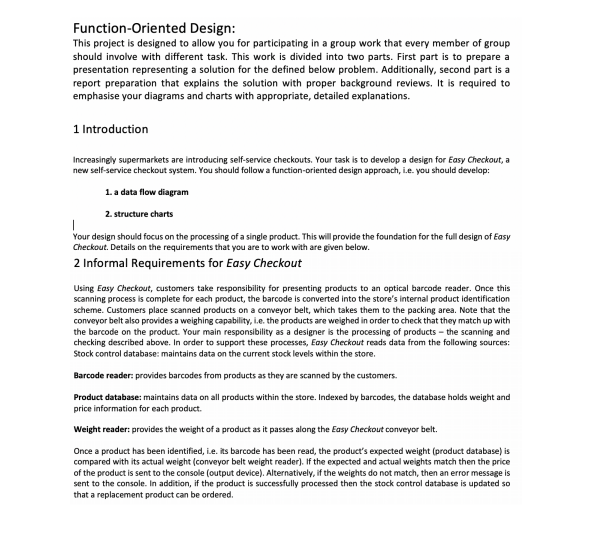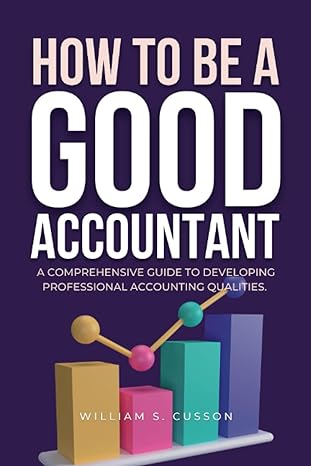
Function-Oriented Design: This project is designed to allow you for participating in a group work that every member of group should involve with different task. This work is divided into two parts. First part is to prepare a presentation representing a solution for the defined below problem. Additionally, second part is a report preparation that explains the solution with proper background reviews. It is required to emphasise your diagrams and charts with appropriate, detailed explanations. 1 Introduction Increasingly supermarkets are introducing self-service checkouts. Your task is to develop a design for Easy Checkout, a new self-service checkout system. You should follow a function-oriented design approach, i.e. you should develop: 1. a data flow diagram 2. structure charts Your design should focus on the processing of a single product. This will provide the foundation for the full design of Easy Checkout. Details on the requirements that you are to work with are given below. 2 Informal Requirements for Easy Checkout Using Easy Checkout, customers take responsibility for presenting products to an optical barcode reader. Once this scanning process is complete for each product, the barcode is converted into the store's internal product identification scheme. Customers place scanned products on a conveyor belt, which takes them to the packing area. Note that the conveyor belt also provides a weighing capability, i.e. the products are weighed in order to check that they match up with the barcode on the product. Your main responsibility as a designer is the processing of products - the scanning and checking described above. In order to support these processes, Easy Checkout reads data from the following sources: Stock control database: maintains data on the current stock levels within the store. Barcode reader: provides barcodes from products as they are scanned by the customers. Product database: maintains data on all products within the store. Indexed by barcodes, the database holds weight and price information for each product. Weight reader: provides the weight of a product as it passes along the Easy Checkout conveyor belt. Once a product has been identified, i.e. its barcode has been read, the product's expected weight (product database) is compared with its actual weight (conveyor belt weight reader). If the expected and actual weights match then the price of the product is sent to the console (output device). Alternatively, if the weights do not match, then an error message is sent to the console. In addition, if the product is successfully processed then the stock control database is updated so that a replacement product can be ordered. Function-Oriented Design: This project is designed to allow you for participating in a group work that every member of group should involve with different task. This work is divided into two parts. First part is to prepare a presentation representing a solution for the defined below problem. Additionally, second part is a report preparation that explains the solution with proper background reviews. It is required to emphasise your diagrams and charts with appropriate, detailed explanations. 1 Introduction Increasingly supermarkets are introducing self-service checkouts. Your task is to develop a design for Easy Checkout, a new self-service checkout system. You should follow a function-oriented design approach, i.e. you should develop: 1. a data flow diagram 2. structure charts Your design should focus on the processing of a single product. This will provide the foundation for the full design of Easy Checkout. Details on the requirements that you are to work with are given below. 2 Informal Requirements for Easy Checkout Using Easy Checkout, customers take responsibility for presenting products to an optical barcode reader. Once this scanning process is complete for each product, the barcode is converted into the store's internal product identification scheme. Customers place scanned products on a conveyor belt, which takes them to the packing area. Note that the conveyor belt also provides a weighing capability, i.e. the products are weighed in order to check that they match up with the barcode on the product. Your main responsibility as a designer is the processing of products - the scanning and checking described above. In order to support these processes, Easy Checkout reads data from the following sources: Stock control database: maintains data on the current stock levels within the store. Barcode reader: provides barcodes from products as they are scanned by the customers. Product database: maintains data on all products within the store. Indexed by barcodes, the database holds weight and price information for each product. Weight reader: provides the weight of a product as it passes along the Easy Checkout conveyor belt. Once a product has been identified, i.e. its barcode has been read, the product's expected weight (product database) is compared with its actual weight (conveyor belt weight reader). If the expected and actual weights match then the price of the product is sent to the console (output device). Alternatively, if the weights do not match, then an error message is sent to the console. In addition, if the product is successfully processed then the stock control database is updated so that a replacement product can be ordered







